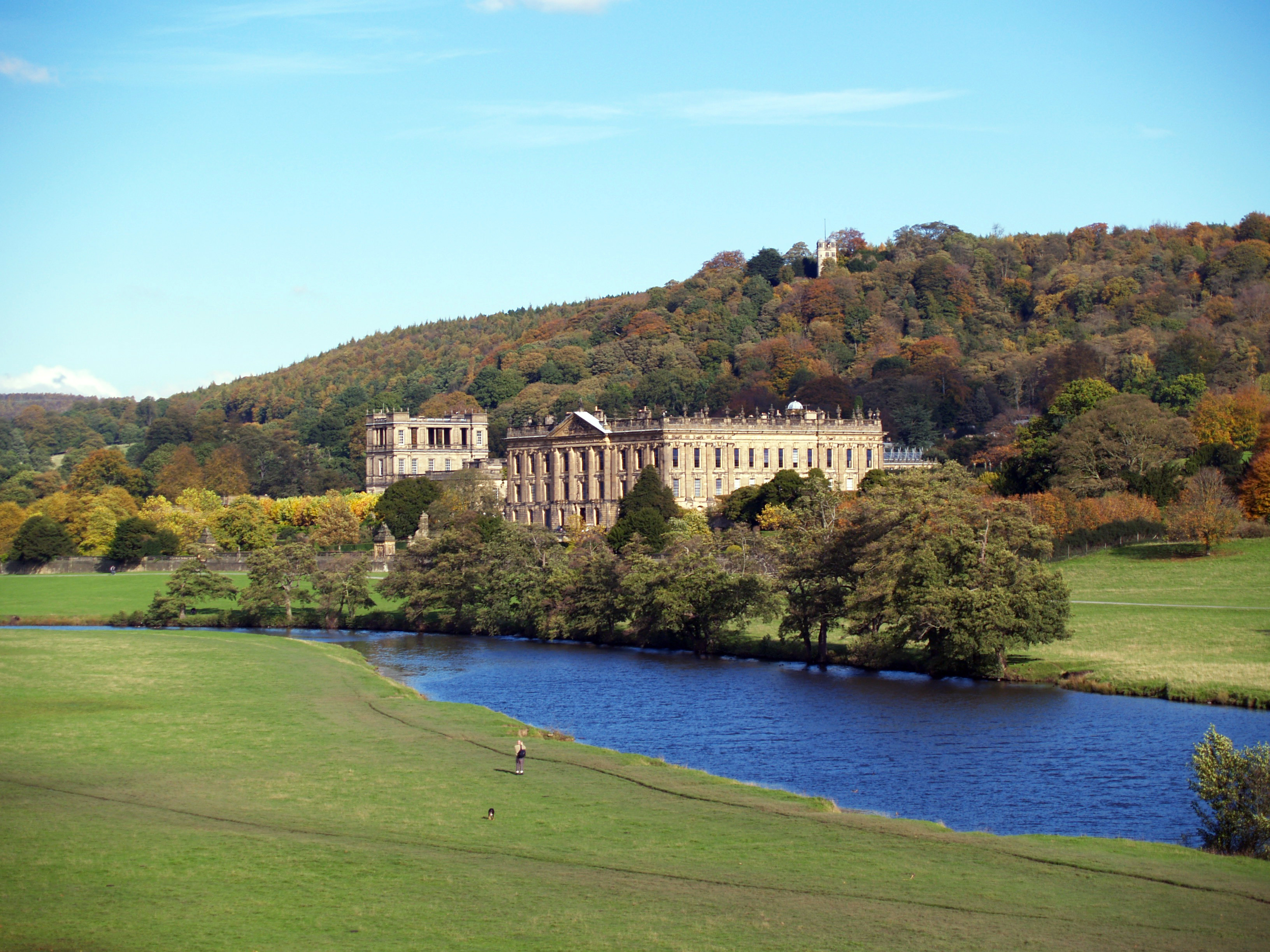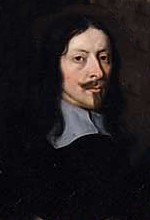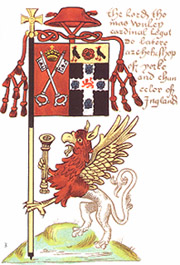|
William Cavendish (courtier)
Sir William Cavendish MP (c. 150525 October 1557) was an English politician, knight and courtier. Cavendish held public office and accumulated a considerable fortune, and became one of Thomas Cromwell's "visitors of the monasteries" during the dissolution of the monasteries. He was MP for Thirsk in 1547. In 1547 he married Bess of Hardwick, and the couple began the construction of Chatsworth House in 1552, a project which would not be completed until after his death. His second son William Cavendish (1552–1626) became the first Earl of Devonshire, purchasing his title from the impecunious King James I. Early life He was the younger son of Thomas Cavendish (1472–1524), who was a senior financial official, the "clerk of the pipe", in the Court of Exchequer, and his wife, Alice Smith of Padbrook Hall. He was the great-great-great-grandson of Sir John Cavendish from whom the Dukes of Devonshire and the Dukes of Newcastle inherited the family name of Cavendish. Career Cavendi ... [...More Info...] [...Related Items...] OR: [Wikipedia] [Google] [Baidu] |
Member Of Parliament
A member of parliament (MP) is the representative in parliament of the people who live in their electoral district. In many countries with bicameral parliaments, this term refers only to members of the lower house since upper house members often have a different title. The terms congressman/congresswoman or deputy are equivalent terms used in other jurisdictions. The term parliamentarian is also sometimes used for members of parliament, but this may also be used to refer to unelected government officials with specific roles in a parliament and other expert advisers on parliamentary procedure such as the Senate Parliamentarian in the United States. The term is also used to the characteristic of performing the duties of a member of a legislature, for example: "The two party leaders often disagreed on issues, but both were excellent parliamentarians and cooperated to get many good things done." Members of parliament typically form parliamentary groups, sometimes called caucuse ... [...More Info...] [...Related Items...] OR: [Wikipedia] [Google] [Baidu] |
Exchequer
In the civil service of the United Kingdom, His Majesty’s Exchequer, or just the Exchequer, is the accounting process of central government and the government's ''current account'' (i.e., money held from taxation and other government revenues) in the Consolidated Fund. It can be found used in various financial documents including the latest departmental and agency annual accounts. It was the name of a British government department responsible for the collection and the management of taxes and revenues; of making payments on behalf of the sovereign and auditing official accounts. It also developed a judicial role along with its accountancy responsibilities and tried legal cases relating to revenue. Similar offices were later created in Normandy around 1180, in Scotland around 1200 and in Ireland in 1210. Etymology The Exchequer was named after a table used to perform calculations for taxes and goods in the medieval period. According to the ''Dialogus de Scaccario'' ('Dial ... [...More Info...] [...Related Items...] OR: [Wikipedia] [Google] [Baidu] |
William Cavendish, 1st Duke Of Newcastle
William Cavendish, 1st Duke of Newcastle upon Tyne, KG, KB, PC (25 December 1676) was an English courtier and supporter of the arts. He was a renowned horse breeder, as well as being patron of the playwright Ben Jonson, and the intellectual group known as the Welbeck Circle. Despite spending the then enormous sum of £15,000 entertaining Charles I in 1634, he failed to gain a significant political post. In the early stages of the First English Civil War, he was appointed Royalist Captain-General in Northern England; he financed much of the war effort himself, later claiming this totalled in excess of £1,000,000. After the defeat at Marston Moor in July 1644, a battle fought against his advice, he went into exile in Europe. He returned to England after the Stuart Restoration in 1660, and although created Duke of Newcastle in 1665, he remained on the fringes of the court, and became critical of Charles II. He died in 1676, and was buried in Westminster Abbey. Personal detail ... [...More Info...] [...Related Items...] OR: [Wikipedia] [Google] [Baidu] |
Charles Cavendish (1553–1617)
Sir Charles Cavendish (28 November 1553 – 4 April 1617) was an English landowner. He was a son of Bess of Hardwick and William Cavendish (1505-1557). Career After Eton and Cambridge, Charles Cavendish and his stepbrother Gilbert Talbot went on a Grand Tour to Venice in 1570 and to Rome in 1574. In July 1582 he had some involvement with Mary, Queen of Scots, who declined his request. Mary wrote in March 1584 that Charles Cavendish was in London, and had kept a pair of swift horses to ride to her with news of Elizabeth's death, the English queen being unwell at this time. He was knighted in 1583. Charles Cavendish wrote to his mother in 1587 describing life at court in London, the reception of Arbella Stuart, and building projects including work at Theobalds which he compared to Chatsworth. The musician and composer John Wilbye dedicated ''The First Set of English Madrigals'' (London, 1598) to Cavendish who had married Margaret Kitson, a daughter of his patrons, the Kitsons ... [...More Info...] [...Related Items...] OR: [Wikipedia] [Google] [Baidu] |
Derbyshire (UK Parliament Constituency)
Derbyshire is a former United Kingdom Parliamentary constituency. It was a constituency of the House of Commons of the Parliament of England then of the Parliament of Great Britain from 1707 to 1800 and of the Parliament of the United Kingdom from 1801 to 1832. It was represented by two Knights of the Shire. History Boundaries and franchise The constituency, which first returned members to Parliament in 1290, consisted of the historic county of Derbyshire. (This included the borough of Derby; even though Derby elected two MPs in its own right, it was not excluded from the county constituency, and owning property within the borough could confer a vote at the county election.) In medieval times, the MPs would have been elected at the county court, by the suitors to the court, which meant the tiny handful of the local nobility who were tenants in chief of the Crown. However, from 1430, the Forty Shilling Freeholder Act extended the right to vote to every man who possessed freeho ... [...More Info...] [...Related Items...] OR: [Wikipedia] [Google] [Baidu] |
Henry Cavendish (politician)
Sir Henry Cavendish (1550–1616) was the eldest son of the Tudor courtier William Cavendish, and Elizabeth Talbot, Countess of Shrewsbury (c. 1527–1608), known as "Bess of Hardwick". He served in the Netherlands as a captain in 1578, and was the MP for Derbyshire five times, but did not participate greatly in politics. Cavendish was also a notorious libertine, and was disinherited by his mother, who held his wardship after his father's death. After his mother's death in 1608 Cavendish inherited the Chatsworth estate, but he sold it to his brother William, who later became the 1st Earl of Devonshire, in the following year. He had a number of illegitimate children, but no legitimate heirs. Early life Henry Cavendish was born in Dec 1550, the eldest son of the politician and courtier Sir William Cavendish and Bess of Hardwick. His father died on 25 October 1557, when the young Henry was only 6 years old. [...More Info...] [...Related Items...] OR: [Wikipedia] [Google] [Baidu] |
Henry Pierrepont (MP)
Sir Henry Pierrepont (1546 – 19 March 1615) was an English MP who resided at Holme Pierrepont, Nottinghamshire. Family He was the son of Sir George Pierrepont and succeeded him in 1564. His mother, Winnifred née Twaits, remarried Sir Gervase Clifton. He married Frances Cavendish, daughter of the Rt. Hon. Sir William Cavendish and Elizabeth Hardwick. The children were: * Grace Pierrepont ThePeerage.com, accessed 27 December 2008 * * Elizabeth Pierrepont, who was brought up in the ... [...More Info...] [...Related Items...] OR: [Wikipedia] [Google] [Baidu] |
Suffolk
Suffolk () is a ceremonial county of England in East Anglia. It borders Norfolk to the north, Cambridgeshire to the west and Essex to the south; the North Sea lies to the east. The county town is Ipswich; other important towns include Lowestoft, Bury St Edmunds, Newmarket, and Felixstowe which has one of the largest container ports in Europe. The county is low-lying but can be quite hilly, especially towards the west. It is also known for its extensive farming and has largely arable land with the wetlands of the Broads in the north. The Suffolk Coast & Heaths and Dedham Vale are both nationally designated Areas of Outstanding Natural Beauty. History Administration The Anglo-Saxon settlement of Suffolk, and East Anglia generally, occurred on a large scale, possibly following a period of depopulation by the previous inhabitants, the Romanised descendants of the Iceni. By the fifth century, they had established control of the region. The Anglo-Saxon inhabitants later b ... [...More Info...] [...Related Items...] OR: [Wikipedia] [Google] [Baidu] |
George Cavendish (writer)
George Cavendish (1497 – c. 1562) was an English writer, best known as the biographer of Cardinal Thomas Wolsey. His ''Thomas Wolsey, Late Cardinall, his Lyffe and Deathe'' is described by the ''Oxford Dictionary of National Biography'' as the "most important single contemporary source for Wolsey's life" which also offers a "detailed picture of early sixteenth-century court life and of political events in the 1520s, particularly the divorce proceedings against Catherine of Aragon. Family Cavendish was born in 1497, the elder son of Thomas Cavendish (d. 1524), who was a senior financial official, the "clerk of the pipe", in the Court of Exchequer, and his wife, Alice Smith of Padbrook Hall, Suffolk. He was the great-grandson of Sir John Cavendish from whom the Dukes of Devonshire and the Dukes of Newcastle inherited the family name of Cavendish. George was an English courtier and author and the brother of William Cavendish, the second husband of Bess of Hardwick. He was probabl ... [...More Info...] [...Related Items...] OR: [Wikipedia] [Google] [Baidu] |
Thomas Wolsey
Thomas Wolsey ( – 29 November 1530) was an English statesman and Catholic bishop. When Henry VIII became King of England in 1509, Wolsey became the king's almoner. Wolsey's affairs prospered and by 1514 he had become the controlling figure in virtually all matters of state. He also held important ecclesiastical appointments. These included the Archbishopric of York—the second most important role in the English church—and that of papal legate. His appointment as a cardinal by Pope Leo X in 1515 gave him precedence over all other English clergy. The highest political position Wolsey attained was Lord Chancellor, the king's chief adviser (formally, as his successor and disciple Thomas Cromwell was not). In that position, he enjoyed great freedom and was often depicted as an ''alter rex'' ("other king"). After failing to negotiate an annulment of Henry's marriage to Catherine of Aragon, Wolsey fell out of favour and was stripped of his government titles. He retreated to ... [...More Info...] [...Related Items...] OR: [Wikipedia] [Google] [Baidu] |
Treasurer Of The Chamber
The Treasurer of the Chamber was at various points a position in the British royal household. 13th century The post of Treasurer of the Chamber first arose in the early 13th century. As part of the evolutionary changes that saw the Treasurer of the Exchequer become an office of state outside the King's Household, one of the Chamber Clerks took on responsibility for financial matters within the Household. The Treasurer of the Chamber had oversight of the Clerks (keepers) of the Wardrobe, among other duties; but in 1232 the office was merged into that of Keeper of the Wardrobe, being one of a number of offices held by Peter Des Rivaux; his successors were known interchangeably as Keepers or Treasurers of the Wardrobe, and the post survives today in the sinecure of Treasurer of the Household. 14th century In the reign of Edward II the influence of the Wardrobe diminished, and the Chamber regained its place of seniority within the Household. In order to enable the Chamber to serve as a ... [...More Info...] [...Related Items...] OR: [Wikipedia] [Google] [Baidu] |
Mary I Of England
Mary I (18 February 1516 – 17 November 1558), also known as Mary Tudor, and as "Bloody Mary" by her Protestant opponents, was Queen of England and Ireland from July 1553 and Queen of Spain from January 1556 until her death in 1558. She is best known for her vigorous attempt to reverse the English Reformation, which had begun during the reign of her father, Henry VIII. Her attempt to restore to the Church the property confiscated in the previous two reigns was largely thwarted by Parliament, but during her five-year reign, Mary had over 280 religious dissenters burned at the stake in the Marian persecutions. Mary was the only child of Henry VIII by his first wife, Catherine of Aragon, to survive to adulthood. Her younger half-brother, Edward VI, succeeded their father in 1547 at the age of nine. When Edward became terminally ill in 1553, he attempted to remove Mary from the line of succession because he supposed, correctly, that she would reverse the Protestant refor ... [...More Info...] [...Related Items...] OR: [Wikipedia] [Google] [Baidu] |

.jpg)

.jpg)


